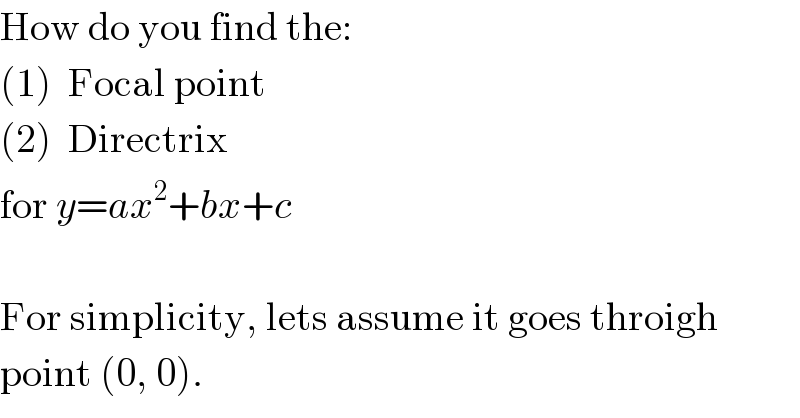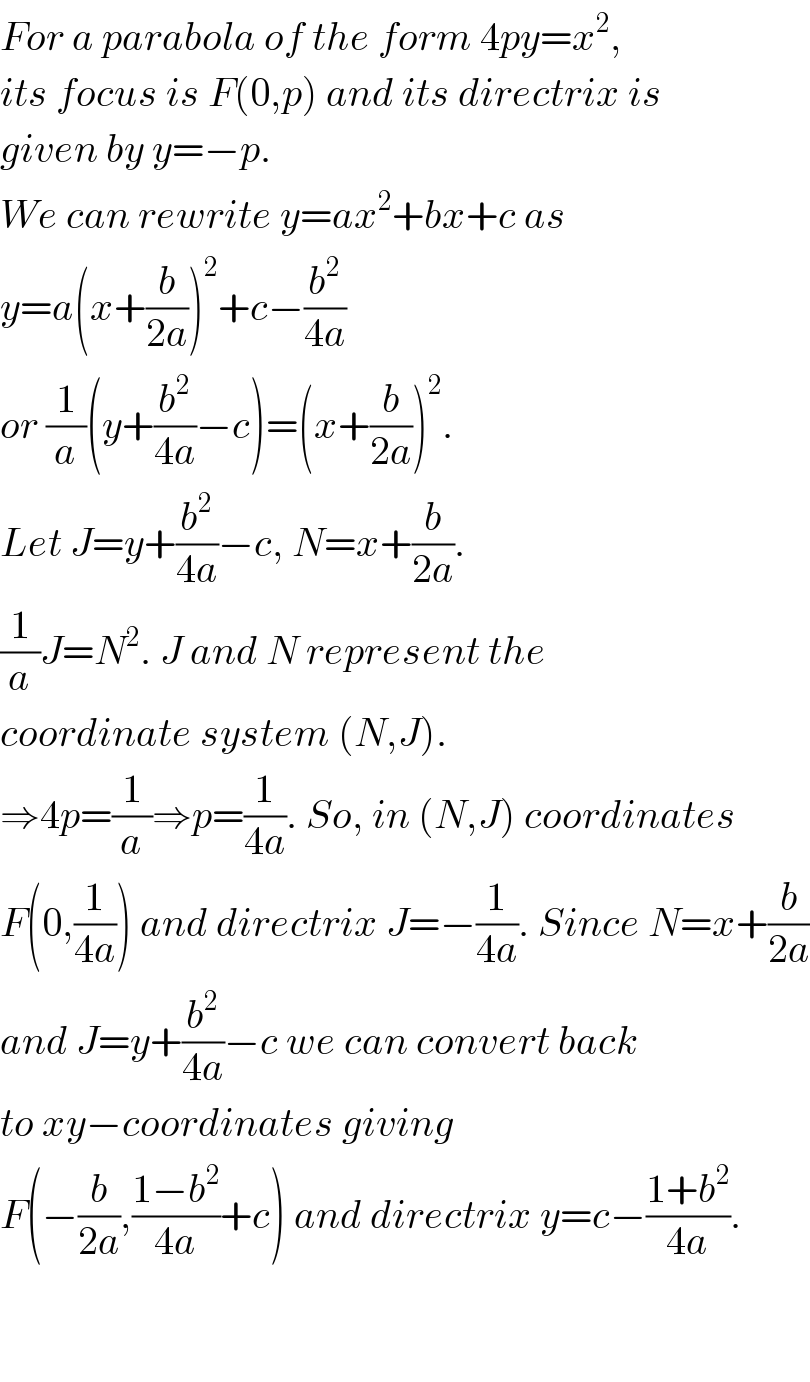Question Number 5113 by FilupSmith last updated on 14/Apr/16

$$\mathrm{How}\:\mathrm{do}\:\mathrm{you}\:\mathrm{find}\:\mathrm{the}: \\ $$$$\left(\mathrm{1}\right)\:\:\mathrm{Focal}\:\mathrm{point} \\ $$$$\left(\mathrm{2}\right)\:\:\mathrm{Directrix} \\ $$$$\mathrm{for}\:{y}={ax}^{\mathrm{2}} +{bx}+{c} \\ $$$$ \\ $$$$\mathrm{For}\:\mathrm{simplicity},\:\mathrm{lets}\:\mathrm{assume}\:\mathrm{it}\:\mathrm{goes}\:\mathrm{throigh} \\ $$$$\mathrm{point}\:\left(\mathrm{0},\:\mathrm{0}\right). \\ $$
Answered by Yozzii last updated on 14/Apr/16

$${For}\:{a}\:{parabola}\:{of}\:{the}\:{form}\:\mathrm{4}{py}={x}^{\mathrm{2}} ,\: \\ $$$${its}\:{focus}\:{is}\:{F}\left(\mathrm{0},{p}\right)\:{and}\:{its}\:{directrix}\:{is} \\ $$$${given}\:{by}\:{y}=−{p}.\: \\ $$$${We}\:{can}\:{rewrite}\:{y}={ax}^{\mathrm{2}} +{bx}+{c}\:{as} \\ $$$${y}={a}\left({x}+\frac{{b}}{\mathrm{2}{a}}\right)^{\mathrm{2}} +{c}−\frac{{b}^{\mathrm{2}} }{\mathrm{4}{a}} \\ $$$${or}\:\frac{\mathrm{1}}{{a}}\left({y}+\frac{{b}^{\mathrm{2}} }{\mathrm{4}{a}}−{c}\right)=\left({x}+\frac{{b}}{\mathrm{2}{a}}\right)^{\mathrm{2}} . \\ $$$${Let}\:{J}={y}+\frac{{b}^{\mathrm{2}} }{\mathrm{4}{a}}−{c},\:{N}={x}+\frac{{b}}{\mathrm{2}{a}}. \\ $$$$\frac{\mathrm{1}}{{a}}{J}={N}^{\mathrm{2}} .\:{J}\:{and}\:{N}\:{represent}\:{the}\: \\ $$$${coordinate}\:{system}\:\left({N},{J}\right).\: \\ $$$$\Rightarrow\mathrm{4}{p}=\frac{\mathrm{1}}{{a}}\Rightarrow{p}=\frac{\mathrm{1}}{\mathrm{4}{a}}.\:{So},\:{in}\:\left({N},{J}\right)\:{coordinates} \\ $$$${F}\left(\mathrm{0},\frac{\mathrm{1}}{\mathrm{4}{a}}\right)\:{and}\:{directrix}\:{J}=−\frac{\mathrm{1}}{\mathrm{4}{a}}.\:{Since}\:{N}={x}+\frac{{b}}{\mathrm{2}{a}} \\ $$$${and}\:{J}={y}+\frac{{b}^{\mathrm{2}} }{\mathrm{4}{a}}−{c}\:{we}\:{can}\:{convert}\:{back} \\ $$$${to}\:{xy}−{coordinates}\:{giving}\: \\ $$$${F}\left(−\frac{{b}}{\mathrm{2}{a}},\frac{\mathrm{1}−{b}^{\mathrm{2}} }{\mathrm{4}{a}}+{c}\right)\:{and}\:{directrix}\:{y}={c}−\frac{\mathrm{1}+{b}^{\mathrm{2}} }{\mathrm{4}{a}}. \\ $$$$ \\ $$$$ \\ $$
